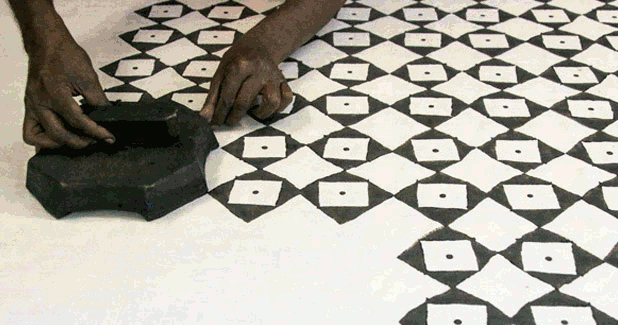
The art of block printing
The block printing has progressed over a period of time accepting to changes in lifestyle, demand and fashion, aver Pradeep Mandal and Neeraj Jaiswal.
The block printing has progressed over a period of time accepting to changes in lifestyle, demand and fashion, aver Pradeep Mandal and Neeraj Jaiswal.
The art of Indian block print textiles is a labour-intensive, painstaking process that has survived from ancient times to the present because of the beauty of the handmade products. Scraps of cloth found in the ruins of MohenjoDaro, an ancient city of the Indus Valley civilisation, provide evidence that block printing was practiced in India as long ago as 3,000 BC. The art flourished in the Twelfth century under the patronage of the rajas. Seventeenth century saw a regeneration of the art. And still, here in the 21st century, block printing of fabric by hand is an art practiced by Indian artisans for the enjoyment of owners of those fabrics throughout the world.
The future of block printing
Block printing has progressed over a period of time accepting to changes in lifestyle, demand and fashion. Since ancient and exotic art forms had taken a back seat due to western influence and globalisation, many of them have given up the art of hand block printing as people have adopted modern and synthetic textiles because hand block printing technique is very time consuming.
While traditional art forms and methods are increasingly being replaced by modern tools, techniques and synthetic dyes, block prints are finally getting recognised due to its unique features that this technique is done only on cotton fabric. The traditional blocks are preserving for reusing and amalgamating with old and new design and art forms, there is a revived interest in preserving the rare art of hand block printing with vegetable dyes.
Block prints are unique, fascinating and interesting. Earlier it was used for clothes and turbans but in current era the block printed textiles are increasingly in demand for apparels and home furnishings. Thus, prints and motifs are preferred for bed spreads, bed sheets, table linen, and fashionable apparels of men, women wear mostly.
The block prints are here to stay in future, as people around the world are increasingly becoming environmentally conscious, soft-on-nature art forms are once again back in demand. Hence, many block printers are depends on skilled and specialised artisans.
Block printing market
Main objective of textile printing is to produce fabric with attractive design and defined pattern. Asia Pacific has the largest market share for textile printing, followed by Europe and North America. China and India alone holds the largest market share for textile printing globally. Europe is expected to witness marginal growth in coming future. The Asia-Pacific region is expected to witness highest growth and maintain its dominance in the forecasted period. Domestic demand in India and China are major regions for increasing demand for textile printing technology in the Asia-Pacific region.
Advancement in technology paired with increasing method of printing is driving the global textile printing market. Additionally, with increasing disposable income customers are able to afford designer ware with attractive design on the fabric; this is again driving the global textile printing market. Also, increased demand for block printing on saris and dress materials is further expected to increase the textile printing technology to some extent.
Products like bed sheets, table mats, napkins, household furnishings, etc. made out using the various styles of textile printed ranging from block printing is in great demand nowadays.
India has many reputed fashion and textile institutes. From the past decade, the National Institute of Design and the National Institute for Fashion Technology are producing budding designers in various apparel and home textile fields and draw their inspiration from Indian prints, painting them on modern silhouettes. The hardcore Indian ethnic prints like block printing and hand dyeing have become common print motifs in the global scenario. Agnimitra Paul, one of Kolkata’s most-loved fashion designers, has a comprehensive and exciting collection. Her Indo-western outfits like maxi dresses have batik, bandhani or kalamkari prints and her sarees with subtle embroidery are teamed with retro blouses.
Conclusion
The demand for the textile printing is expected to increase globally, and this turn will drive the market in coming future. The increasing popularity of textile printing throughout international market will stand in the market growth in future. People moving towards more artistic and royal choices will also positively influence the textile printing market. Increasing the double income of the middle-class people is expected to enhance the global textile printing market in the near future. Changing preferences of the people for wearing clothes will supplement the global market growth in future.
From this study, it can be concluded that with passage of time awareness of the people towards the ethnic art of the country is increasing hence block printing is becoming popular day by day. So units at both levels that is at cottage level and small scale level are increasing, which are providing employment opportunities to all.
References
- http://www.india-crafts.com
- http://cbseacademic.in
- http://www.craftandartisans.com
- http://www.fibre2fashion.com
- http://treesouls.com/eco-living/revival-of-traditional-eco-friendly-hand-block-printing-in-bagru-rajasthan/
- http://www.persistencemarketresearch.com/market-research/textile-printing-market.asp
- https://www.zionmarketresearch.com/report/textile-printing-market
Pradeep Mandal is Assistant Professor with the Department of Textile Design. He can be contacted on: Email: pradeep.mandal077@gmail.com
Neeraj Jaiswal is Assistant Professor with the Department of Fashion Technology, National Institute of Fashion Technology, Kangra, Chheb, Himachal Pradesh, 176001.




